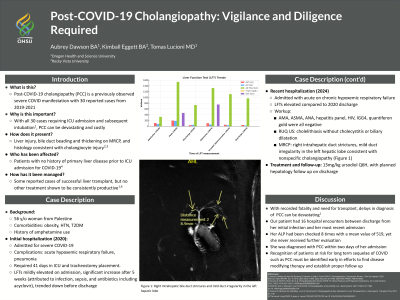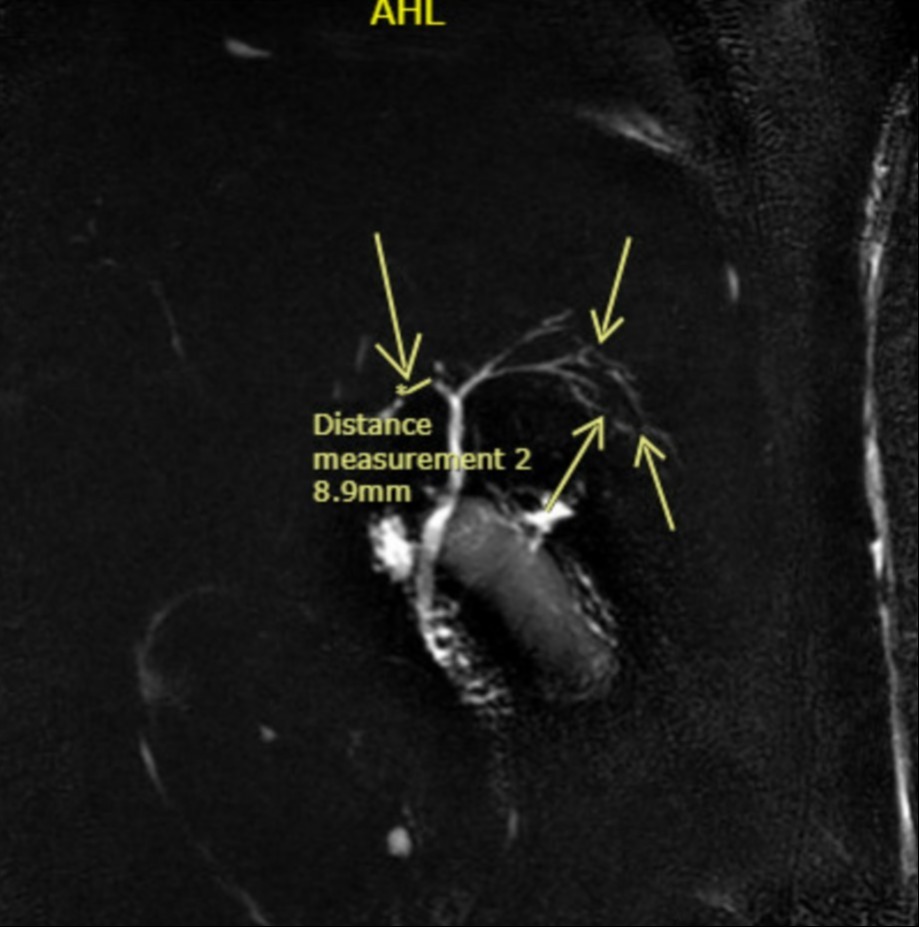Tuesday Poster Session
Category: Liver
P4835 - Post-COVID-19 Cholangiopathy: Vigilance and Diligence Required - A Case Report
Tuesday, October 29, 2024
10:30 AM - 4:00 PM ET
Location: Exhibit Hall E

Has Audio
- AD
Aubrey Dawson, BA
Oregon Health & Science University
Portland, OR
Presenting Author(s)
Award: Presidential Poster Award
Aubrey Dawson, BA1, Kimball Eggett, BA2, Tomas Lucioni, MD1
1Oregon Health & Science University, Portland, OR; 2Rocky Vista University, Colorado Springs, CO
Introduction: Post-COVID-19 cholangiopathy (PCC) is a previously observed phenomenon with 30 reported cases from 2019-2021, all of whom required ICU admission and subsequent intubation1. The rarity and severity of PCC warrants further observation and discussion to quickly identify patients at risk.
Case Description/Methods: We present the case of a 56 year old Palestinian woman with a history of papillary thyroid carcinoma, HTN, type 2 diabetes, obesity and previous amphetamine use who was initially hospitalized for severe COVID-19 in 2020 requiring intubation and 41 days of ICU level care. LFTs during admission were significantly elevated and attributed to a combination of viral infection, sepsis and medications.
During her most recent admission she presented with acute on chronic hypoxic respiratory failure and incidentally noted LFTs with similar AST/ALT but markedly elevated alk phos from priors, prompting further hepatobiliary evaluation. Right upper quadrant ultrasound revealed known cholelithiasis without evidence of cholecystitis or biliary ductal dilatation. AMA, ASMA, ANA, hepatitis panel, HIV, IGG4 and quantiferon gold studies all resulted negative. MRCP revealed right intrahepatic bile duct strictures and mild duct irregularity in the left hepatic lobe consistent with COVID-19 cholangiopathy1.
Discussion: Due to the novelty and rarity of PCC, the scientific community continues to rely heavily upon case reports. Unlike the majority of cases described by Yanny et al. (2023), our patient is a woman with peak LFTs well below the mean. She was diagnosed with PCC within two days of her admission. While COVID-19 continues to be problematic, its long-term consequences are not yet fully understood. With recorded fatality and need for transplant, PCC must be quickly identified1. Our patient had 16 hospital encounters between discharge from her initial infection and her most recent admission. Her ALP had been checked 8 times with a mean value of 519, yet she never received further evaluation. Recognition of patients at risk for long term sequelae of COVID such as PCC must be identified early in efforts to find disease modifying therapy and establish proper follow up.
References

Note: The table for this abstract can be viewed in the ePoster Gallery section of the ACG 2024 ePoster Site or in The American Journal of Gastroenterology's abstract supplement issue, both of which will be available starting October 27, 2024.
Disclosures:
Aubrey Dawson, BA1, Kimball Eggett, BA2, Tomas Lucioni, MD1. P4835 - Post-COVID-19 Cholangiopathy: Vigilance and Diligence Required - A Case Report, ACG 2024 Annual Scientific Meeting Abstracts. Philadelphia, PA: American College of Gastroenterology.
Aubrey Dawson, BA1, Kimball Eggett, BA2, Tomas Lucioni, MD1
1Oregon Health & Science University, Portland, OR; 2Rocky Vista University, Colorado Springs, CO
Introduction: Post-COVID-19 cholangiopathy (PCC) is a previously observed phenomenon with 30 reported cases from 2019-2021, all of whom required ICU admission and subsequent intubation1. The rarity and severity of PCC warrants further observation and discussion to quickly identify patients at risk.
Case Description/Methods: We present the case of a 56 year old Palestinian woman with a history of papillary thyroid carcinoma, HTN, type 2 diabetes, obesity and previous amphetamine use who was initially hospitalized for severe COVID-19 in 2020 requiring intubation and 41 days of ICU level care. LFTs during admission were significantly elevated and attributed to a combination of viral infection, sepsis and medications.
During her most recent admission she presented with acute on chronic hypoxic respiratory failure and incidentally noted LFTs with similar AST/ALT but markedly elevated alk phos from priors, prompting further hepatobiliary evaluation. Right upper quadrant ultrasound revealed known cholelithiasis without evidence of cholecystitis or biliary ductal dilatation. AMA, ASMA, ANA, hepatitis panel, HIV, IGG4 and quantiferon gold studies all resulted negative. MRCP revealed right intrahepatic bile duct strictures and mild duct irregularity in the left hepatic lobe consistent with COVID-19 cholangiopathy1.
Discussion: Due to the novelty and rarity of PCC, the scientific community continues to rely heavily upon case reports. Unlike the majority of cases described by Yanny et al. (2023), our patient is a woman with peak LFTs well below the mean. She was diagnosed with PCC within two days of her admission. While COVID-19 continues to be problematic, its long-term consequences are not yet fully understood. With recorded fatality and need for transplant, PCC must be quickly identified1. Our patient had 16 hospital encounters between discharge from her initial infection and her most recent admission. Her ALP had been checked 8 times with a mean value of 519, yet she never received further evaluation. Recognition of patients at risk for long term sequelae of COVID such as PCC must be identified early in efforts to find disease modifying therapy and establish proper follow up.
References
- Yanny B, Alkhero M, Alani M, Stenberg D, Saharan A, Saab S. Post-COVID-19 Cholangiopathy: A Systematic Review. J Clin Exp Hepatol. 2023 May-Jun; 489-499.
- The Lancet. Long COVID: 3 years in. Lancet. 2023 Mar; 795.

Figure: Figure 1: Right intrahepatic bile duct strictures and mild duct irregularity in the left hepatic lobe
Note: The table for this abstract can be viewed in the ePoster Gallery section of the ACG 2024 ePoster Site or in The American Journal of Gastroenterology's abstract supplement issue, both of which will be available starting October 27, 2024.
Disclosures:
Aubrey Dawson indicated no relevant financial relationships.
Kimball Eggett indicated no relevant financial relationships.
Tomas Lucioni indicated no relevant financial relationships.
Aubrey Dawson, BA1, Kimball Eggett, BA2, Tomas Lucioni, MD1. P4835 - Post-COVID-19 Cholangiopathy: Vigilance and Diligence Required - A Case Report, ACG 2024 Annual Scientific Meeting Abstracts. Philadelphia, PA: American College of Gastroenterology.

